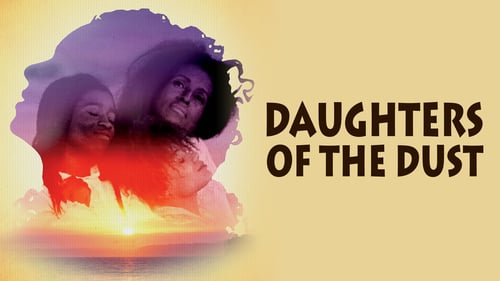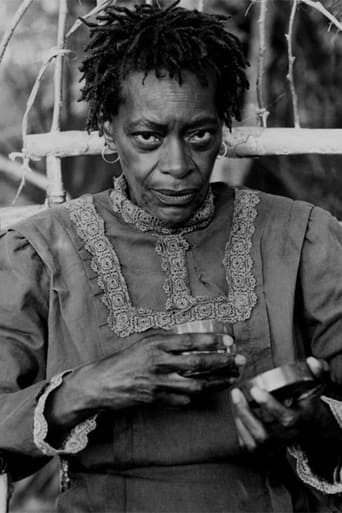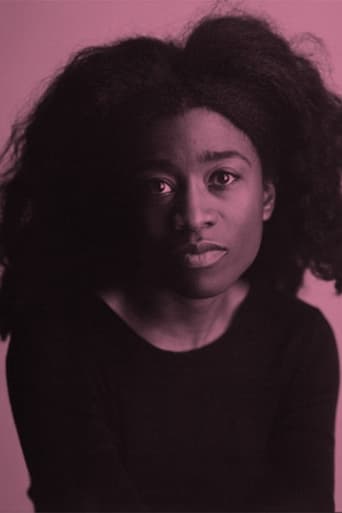FuzzyTagz
If the ambition is to provide two hours of instantly forgettable, popcorn-munching escapism, it succeeds.
Senteur
As somebody who had not heard any of this before, it became a curious phenomenon to sit and watch a film and slowly have the realities begin to click into place.
Portia Hilton
Blistering performances.
Fatma Suarez
The movie's neither hopeful in contrived ways, nor hopeless in different contrived ways. Somehow it manages to be wonderful
lasttimeisaw
"This must be the most desolate place on earth." is uttered in this ethnographic trailblazer from Julie Dash, and the said place is Igbo Landing, on St. Simons Island off the Georgia coast, where lives Gullah islanders, an African-American people distinctively preserves its African traditions and origins. The story of DAUGHTERS OF THE DUST takes place in the turn of the 20th century, and pivots around the Peazant Clan when the family is facing an impending separation as most of them decide to pursue a new, modern life northward in the mainland, whereas the elderly matriarch Nana (Cora Lee Day), refuses to leave the island where she is born and raised. Weaving its non-linear narrative with a voice-over of the unborn child (Warren), whose dubious parentage is a scathing testimony of Gullah people's sufferance to the injustice and oppression (although they are not explictly presented here), strewing flashback, spectacular shots of its unique topography, myths (water-walking), rituals (baptism) and supernaturalism (a young girl's ghost or a surreal shot in the graveyard) intermittently along the way, yet, on a less favorable note, its banally synthesized accidental music (save for some tribal rhythm) fails to leaven the narrative as the icing on the cake, often irritatingly takes us away from its spatio-temporal environs. It is a shade daunting for a first-time viewer to suss the whole picture of who is who and their familial relations immediately, but it is rewardingly the women's voices are predominantly heard through a handful of strong characters. Cora Lee Day's Nana, an obstinate heathen refuses to evangelism but cleaves to memories and mementos of the past in her own superstitious mindset, is a stunning exemplar of what energy and impact those underemployed dark-skinned thespians can generate if they are granted a platform, she is electrifying as the old guard battling mortality and being forgotten, subsists a wisp of spiritual tenacity that becomes her lifeline. Barbarao plays Yellow Mary, one of Nana's many granddaughters, the black sheep practicing the oldest profession, returns for the last supper with her same-sex lover Trula (Hoosier), is at loggerheads with Haagar (Moore), Nana's intractable granddaughter-in-law, who aims to sever her family entirely from the backwater, represents the aggressive side of the polarity. Finally, Alva Rogers as Eula, mother of the unborn child and wife of Nana's great grandson Eli (Anderson), staggeringly performs a quasi-possessed plea of understanding and unification in the climax, conjuring up a most theatrical moment in this otherwise self-reflective, desultory essay honoring Gullah culture and underlining the inexorable generational shift and a muted understanding thereof. An oddity disinterred from oblivion, and forever enshrined as the first feature film directed by an African-American woman distributed theatrically in the United States, Dash's ethereal debut enters that year's Sundance and is recognized for its otherworldly cinematography, but its groundbreaking genesis doesn't parlay into a successive big screen career for Dash, who is relegated to small screen works mostly and his second theatrical film FUNNY VALENTINES arrives in 1999, and that's it, does she deserve another chance? For shizzle!
katsii-1
Most of the other comments have described what I loved about the film. It's one of my all-time favorites. I may have had an advantage - having just returned from a year in Jamaica when I first saw the film - the language was understandable to me without the subtitles most of the time. I have to say - I don't understand the folks that didn't get it. This film spoke to something deep inside me...something that perhaps all women share, whatever their background or color. Yes, it deepens ones understanding of a particular time and of a particular culture...but for me it goes way beyond that. I can only say, if you haven't seen it, rent it - decide for yourself. You'll thank me :).
atdamovies
Daughters of the DustJulie Dashes film Daughters of the Dust attempts to show the struggles of African Americans who's ancestors had been brought to a west Indian island. The scenery is beautiful as one could imagine having been filmed on a tropical paradise. The shots of the beach and ocean as well as further inland are amazing. Dash draws attention to this by on at least two occasions placing people in the trees for their dialogue scenes, the Cherokee and yellow Mary each have scenes in which they are sitting in trees. Also the colors that are used in some scenes, such as the blue tinting of the ocean when the little girl is running across the beach, enhance the image. In one very nice shot the camera is flying over what looks like a big sand bar that is protruding from the edge of the island. So successful is Dash at showing the beauty of the island that through out most of the film I found myself wishing that I was on it. However that might have something to do with her failure to construct an interesting story to go along with the eye-catching island landscape. The story is told through the recollection of a young girl who isn't born yet, she's telling the past as it was told to her. This along with the written heading at the beginning of the film initially give the film a documentary type feel. However the plot of the film move from there to become a one sided look at this family's existence on the island. One sided not in the sense that we don't get any male role models and in fact no males role is well defined. In her painstaking attempt at showing each of the females' roles on the island Dash forgets that the men probably had some part to play in the way of life of the family. For instance the cameraman in the movie is not even close to being anything other than a distraction. Is he the boyfriend of the Christian woman or just her cameraman? If he is just the cameraman why does he seem to have more than that as his driving force and if he is her boyfriend why does she introduce him as the cameraman? This may seem trivial but in a movie where the roles of men are unclear, it would be nice to have at least one man who isn't just an onlooker. The same can be said about the main island man. He seems to be at the mercy of his wife as well as the old mystic lady. Both of which seem to only confuse and agitate him. Even after the cameraman asks about the man who had been brought by the slave ship as a boy, the Christian lady says that he's crazy and implies that he isn't worth talking to. When the cameraman does talk to him he seems far from crazy but still we don't get to hear his story, at least not convincingly. The closest thing to any male authority is when the husband of the woman who was raped gets into a weird fight like thing with a mysterious man who has no role in the move other than that one confrontation. No society either on an island or on a mountain can survive without all of it's members playing an important role. In this movie the men had no role.It is worth saying that if in fact the film is ment to take place over the period of only one day the filmmaker could get around having to show the roles of the men in her focus on the women's duties that day. If that is the case and this was to be just one day, then in that aspect she also failed as that was not evident to me.
erock02
Daughters of the Dust directed by Julie Dash is a cultural perspective look into the lives of an African American family left on an island years after being torn from their heritage of Africa for slavery only to have revolted and be left to themselves, stranded on the island off the coast of the Southern eastern coast and the family who live off the island with others who long to find their heritage. The film's story line is developed in the one day where the family is getting ready to head to a new world on the main land. The internal conflict of the family between relatives who no longer live on the island who have become part of the culture of America post civil war and the family left on the island that live by the old heritage and customs. The family on the island struggle between their history and culture to the change of the times and the need for conformity. This film centers on the generations of the family from the young children who are filled with life then to the adults who are torn between their decisions to leave to finally the center character, the elder grandmother of the family Nana. Nana's ways and beliefs that have been accepted by the family their entire lives are now the only thing holding the family back from their future off the island. The film focuses largely on the women of the family, displaying the differences of ones who that have lived on the island and then those whom have lived off it. The lines divided between the two are evidently shown throughout the film. The women who lived off the island no longer take to heart their heritage that Nana lives by. They find it to be uncivilized and against the teaching of the bible. There is the scene in which the family after much struggle and torment accept Nana's decision to stay and her heritage. The scene is of the entire family gathered around the grandmother in which she has a lock of her hair and others placed on a bible asking everyone to believe in the old ways and take her with her by kissing the hair and bible. Finally, the scene acts as importance because one of the outside family members whom diligently preaches and believes in Christianity gives in to Nana's request.Daughters of the Dust cannot be explained without stating the mise en cinema. From the clothing to the shots of the landscape of the island all resemble the time and place of the film. Not only the background and clothes, but also the character themselves turn this limited distributed film into a believable representation of what people of this time would act and be. The storyline background of the slavery uprising actually having taken place on the island gives it enormous creditability. The shots of the island start the creditability of the film with shots of the women interacting with the water of the ocean and the rivers, the shots of the forest and trees, and finally the most significant may be when the women are preparing the dinner showing how their food is prepared with live seafood and spices gathered from the island. The mise en cinema is creditable because of the clothes as well; from Nana who has only a dress is indigo, which was the main produce to harvest by the slaves on the island to the white Victorian dress of the women from the main land.Dash's Daughters of the Dust cannot be denied as a cultural perspective that's originality has touched on the transition to the new culture of African Americans and they past that many have forgotten after the postwar civil war era. Its cultural insight may have been directed to a certain selected target audience, but its look into the heritage of the people cannot be viewed as anything but a respectable insight of the times.






